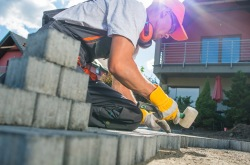Investing in a paved driveway is a smart way of preventing slips and falls, providing additional parking for family and friends, and improving curb appeal.
 Homeowners can expect to pay from R85 per square metre to R200 per square metre to have paving installed in their driveway, and anywhere from R85 per square metre to R300 per square metre for the raw materials.
Homeowners can expect to pay from R85 per square metre to R200 per square metre to have paving installed in their driveway, and anywhere from R85 per square metre to R300 per square metre for the raw materials.Find out what it will cost you, what the available options are and how you can install your own paving.
Jason Greer from Beyond Paving shares some tips…
- What are the different paver options I can use?
Homeowners can choose from brick, cement brick or cobbles.
- What will it cost to pave my driveway?
Each company has their own labour rate, which generally includes the basic ground preparation, the relevant materials used to install the pavers, as well as the compaction and grouting thereof.
These rates range from R85 per square metre to R200 per square metre, and are based on a number of variables including quality of workmanship, warranties and service delivery promises.
The raw materials (i.e. pavers) can cost anywhere from R85 per square metre to R300 per square metre.
 When installing pavers, ideally you want to go for a herringbone pattern. Place them together as tightly as possible, leaving gaps for where you’ll need to cut the pavers to fit.
When installing pavers, ideally you want to go for a herringbone pattern. Place them together as tightly as possible, leaving gaps for where you’ll need to cut the pavers to fit.Plain versus complex design costs
The more complex the design of the driveway paving, the longer it will take to pave the driveway. Cost in this regard shouldn’t really be affected, although one might have to order more paving due to the amount of additional cuts required for a complex design.
Slopes, curves and drain costs
When it comes to slopes, curves and drains, the only additional cost here will be the purchase of a drain which might only be necessary if the natural gradient (slope) of the driveway is heading towards the garage. If this is case, the drain (grid system) will be installed at the entrance of the garage.
- Are there additional costs that I should consider?
Usually, homeowners will have to factor in rubble removal and additional material transport costs (if any).
 If the idea of paving or installing a drain becomes overwhelming, and you’re too nervous to tackle it on your own, call a professional.
If the idea of paving or installing a drain becomes overwhelming, and you’re too nervous to tackle it on your own, call a professional.- What are the pros and cons of the different paving stones?
When installing cobble paving, it is advised that you seal them to retain their colour and to prevent stains, while clay pavers weather really well.
Although cement paving is a hardy option, eventually it will start to look rough.
DIY step-by-step guide to installing driveway paving
Driveways are usually large, sloped areas which lend themselves well to having a professional company install the paving for you. But, if your favourite show was ‘Home Improvement’ and you grunt like the tool man himself, here’s a short guide on how to do it yourself…
Step 1
Remove all existing paving and start on a clean slate.
Step 2
 Investing in a paved driveway is a smart way of preventing slips and falls, providing additional parking for family and friends, and improving curb appeal.
Investing in a paved driveway is a smart way of preventing slips and falls, providing additional parking for family and friends, and improving curb appeal.Make sure you do your best to manipulate the gradient so that water will flow away from your garage and house. Then, compact the area using a plate compactor.
Step 3
Lay down a bed of river sand (typically 20mm) onto which you will lay your pavers. Do this in stages, as you don’t want the river sand to dry out.
Step 4
Install the pavers, ideally in a herringbone pattern. Place them together as tightly as possible, leaving gaps for where you’ll need to cut the pavers to fit.
Step 5
Cut the pavers where necessary to ensure an even flow and pattern throughout the design.
Step 6
You can now grout the driveway using a mix of plaster sand and cement. This will lock the pavers in place.
Step 7
Lightly water the newly paved area. This will move the final bits of loose plaster sand and cement into the gaps, as well as clean the paving.
- When to call a professional
If the idea of paving or installing a drain becomes overwhelming, and you’re too nervous to tackle it on your own, call a professional. It’ll be done in a fraction of the time and most installers come with a workmanship guarantee that will leave you with some peace of mind.- Katlego Sekano








